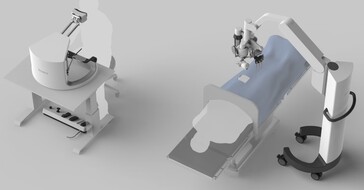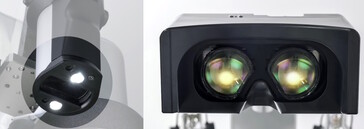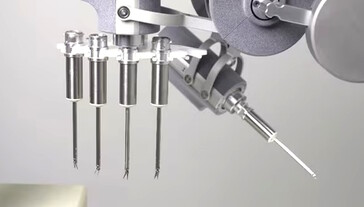Sony has showcased a supermicrosurgery robot with 4K 3D cameras and OLED displays to assist surgeons during operations. Supermicrosurgery is surgery conducted on the smallest of blood vessels, nerves, and tissues such as those in a finger. Reattachment and repair work on blood vessels and nerves of 0.3 to 0.8 millimeters require top surgeons who have practiced for many years.
Supermicrosurgery began with the pioneering work of Dr. Isao Koshima two decades ago. Robotic systems for supermicrosurgery on humans emerged in 2020 with the Microsure MUSA. Such alternatives have disadvantages, such as manual surgical tool changes and the use of optical lenses to magnify the surgical field of view, thus requiring the surgeon and assistants to stand next to the patient during long surgeries.
The Sony surgical robot brings multiple advantages to supermicrosurgery.
- A tabletop console controls the robot remotely. This allows surgeons to sit comfortably during long operations and opens the door to future operations from afar.
- Digital 3D view of the surgical field. Dual 4K cameras feed into 4K OLED microdisplays in the stereo viewer at the console. The surgeon does not need to stand next to the patient to see the surgical field.
- Hand comfort. A pair of lightweight, hand controllers allow comfortable manipulation of tissues and tools from the remote console. Both hands can sit on the hand rest to reduce fatigue.
- Automatic instrument exchange. The surgeon can easily switch tools, speeding up surgeries by eliminating the need for an assistant to hand over surgical tools.
- Low latency, low friction robotic arms with motion scaling. The system reduces surgeon hand motions by a scale of ½ to 1/10 while retaining high responsiveness.
The prototype was showcased at the 2024 IEEE International Conference on Robotics and Automation held from May 13 to 17, 2024 in Yokohama, Japan and joins the small world of emerging robotic systems capable of supermicrosurgery such as the Microsure MUSA-3. Readers who think they can do better can start prototyping with a robotic arm kit (like this one on Amazon).
May 9, 2024
Sony Develops Proprietary Microsurgery Assistance Robot
Prototype first unveiled at ICRA2024 Sony Booth
Tokyo, Japan - Sony Group Corporation (Sony) today announced the development of a microsurgery assistance robot capable of automatic surgical instrument exchange and precision control. The prototype will be unveiled at the Sony booth during the 2024 Institute of Electrical and Electronics Engineers (IEEE) International Conference on Robotics and Automation (ICRA2024), which opens in Yokohama on May 13.
Prototype of the microsurgery assistance robot
Factors such as a shrinking workforce caused by an aging society have resulted in a serious shortage of medical practitioners, who face an increased workload in the medical field. Against this backdrop, in the field of surgery where high skill levels are required, the use of surgical robots that assist with precision operations is expected to reduce surgeon workloads and help promote the spread of advanced medical services.
The prototype was developed by Sony's R&D team for technology development to assist in microsurgical procedures for use in conjunction with a microscope, etc., to work on extremely small tissues, such as veins and nerves. The movements of the surgeons' hands and fingers captured with a highly sensitive control device are replicated on a small surgical instrument that operates smoothly, akin to the movement of the human wrist. Practical challenges with conventional surgical assistant robots include interruptions and delays in surgery due to manually exchanging surgical instruments, but the R&D team has developed a system that allows for the automatic exchange of these parts through miniaturizing them. In so doing, the R&D team has been seeking the possibility to allow the robot to assist in a wide variety of surgical procedures, enabling more medical practitioners to perform microsurgeries that require extremely delicate operations in the future.
In February 2024, an experiment was conducted by Aichi Medical University, where surgeons and other medical practitioners that do not specialize in microsurgical procedures used the prototype and successfully created an anastomosis in animal blood vessels (diameter of approximately 0.6 mm). This is the world's first case of microvascular anastomosis achieved using a surgical assistance robot with an automatic instrument exchange function*.
- *According to Sony research, as of May 9, 2024.
Going forward, Sony plans to work with university medical departments and medical institutions to further develop and verify the effectiveness of robotic surgical assistance technology. Continuing to move forward with R&D, the company aims to help resolve issues in the medical domain and contribute to the advancement of medicine by providing robotic technologies.
A demonstration video of this technology can be viewed on YouTube.
Main Technology Features
1. Automatic instrument exchange achieved through miniaturization of surgical instruments
Developing miniaturized, proprietary surgical instruments allows multiple instruments to be stored in a compact manner near the robot arm. Both the left and right arms can then use small movements to exchange the instruments in a short period of time without human intervention.
Surgical instrument storage and robot arm
2. Pairing a highly sensitive control device with compact, multi-jointed surgical instruments delivers stable, high-precision control
To enable the stable and high-precision control required in microsurgical procedures, the team developed a compact, lightweight, highly sensitive control device to reflect the delicate movements of human fingertips. Also, the tip of the surgical instrument is equipped with multiple joints, allowing it to move smoothly like the human wrist. Through these features, the prototype aims to enable nimble operation and smooth movement that almost feels like the robot intervention doesn't exist.
Tip of the surgical instrument / Control device
3. High-definition 4K imaging technology to assist with precision operations
The prototype is equipped with 1.3-type 4K OLED Microdisplays developed by Sony Semiconductor Solutions Corporation, allowing operators to view high-definition images of the affected area and the movement of surgical instruments. The prototype aims to provides visual support for microsurgical procedures through faithful reproduction of color, texture and depth.
Equipped with 1.3-type 4K OLED Microdisplays
For further details on the technology, refer to here.
International Conference on Robotics and Automation (ICRA)
This event, held annually by the IEEE Robotics and Automation Society, is the leading international conference for robotics engineering and automation.
- Dates:May 13 - 17, 2024
- Venue:PACIFICO Yokohama
- Sony booth:IC101
- Note: Advance registration is required to attend. See the ICRA2024 official website for details.
- Note: This surgical assistant robot is currently in the development phase and has not obtained approval under Japan's Act on Securing Quality, Efficacy and Safety of Products Including Pharmaceuticals and Medical Devices. The prototype cannot be sold or offered.












